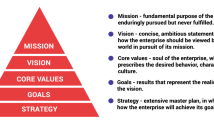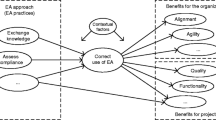Abstract
The Enterprise Coherence-governance Assessment (ECA) instrument is a part of the GEA (General Enterprise Architecting) method for enterprise architecture. Based on experiences with this assessment instrument in a range of real world projects, the ECA has been improved, leading to the extended Enterprise Coherence-governance Assessment (eECA). So far, the eECA been applied in 54 organizations with a total of 120 respondents. The paper discusses the context in which the eECA instrument was developed, the instrument itself, as well as the results of the assessment study in which the instrument was applied.
The ECA and eECA use the term ‘coherence’ rather than the more common term ‘Business-IT alignment’, since the latter is generally associated with bringing only ‘Business’ and ‘IT’ inline. The word coherence, however, stresses the need to go beyond this. Enterprise coherence involves connections and synchronisation between all important aspects of an enterprise. ‘IT’ and ‘Business’ just being two of these aspects.
This work has been partially sponsored by the Fonds National de la Recherche Luxembourg ( www.fnr.lu ), via the PEARL programme.
Access this chapter
Tax calculation will be finalised at checkout
Purchases are for personal use only
Preview
Unable to display preview. Download preview PDF.
Similar content being viewed by others
References
Enterprise architecture maturity model version 1.3. Technical report, National Association of State Chief Information Officers (NASCIO), United States of America (2003), http://www.nascio.org/
Abcouwer, A., Maes, R., Truijens, J.: Contouren van een generiek model voor informatiemanagement. Primavera working paper, Universiteit van Amsterdam (1997) (in Dutch)
Chandler, A.D.: Strategy and Structure, Chapters in the History of the American Industrial Enterprise. The MIT Press, Cambridge (1969) ISBN-10: 0262530090
Collins, J., Porras, J.: Building Your Company’s Vision. Harvard Business Review (1996)
De Caluwé, L., Vermaak, H.: Learning to Change: A Guide for Organization Change Agents. Sage publications, London (2003) ISBN-10: 9014961587
Department of Commerce, Government of the USA. Introduction - IT Architecture Capability Maturity Model. Government of the United States of America (2003)
Fehskens, L.: Deriving Execution from Strategy: Architecture and the Enterprise. In: Open Group Conference Amsterdam (October 2010)
Gordijn, J., Akkermans, H.: Value based requirements engineering: Exploring innovative e-commerce ideas. Requirements Engineering Journal 8(2), 114–134 (2003), doi:10.1007/s00766-003-0169-x
Graves, T.: Real Enterprise Architecture: beyond IT to the whole enterprise. Tetradian Books, Colchester, England, United Kingdom (2008) ISBN-13: 9781906681005, http://tetradianbooks.com
Greefhorst, D., Proper, H.A.: Architecture Principles – The Cornerstones of Enterprise Architecture. Enterprise Engineering Series. Springer, Berlin (2011) ISBN-13: 9783642202780, http://www.springer.com/business+%26+management/business+information+systems/book/978-3-642-20278-0
Henderson, J.C., Venkatraman, N.: Strategic alignment: Leveraging information technology for transforming organizations. IBM Systems Journal 32(1), 4–16 (1993)
Hoogervorst, J.A.P.: Enterprise Governance and Enterprise Engineering. Springer, Berlin (2009) ISBN-13: 9783540926702
Iacob, M.-E., Jonkers, H., Lankhorst, M.M., Proper, H.A.: ArchiMate 1.0 Specification. The Open Group (2009) ISBN-13: 9789087535025
Iacob, M.-E., Jonkers, H., Lankhorst, M.M., Proper, H.A., Quartel, D.A.C.: ArchiMate 2.0 Specification. The Open Group (2012) ISBN-10: 1937218003
Kaplan, R.S., Norton, D.P.: The Strategy-Focused Organization: How Balanced Scorecard Companies Thrive in the New Business Environment. Harvard Business School Press, Boston (2000) ISBN-10: 1578512506
Object Management Group. Business process modeling notation, v1.1. OMG Available Specification OMG Document Number: formal/2008-01-17 (January 2008)
OMG. UML 2.0 Superstructure Specification – Final Adopted Specification. Technical Report ptc/03–08–02 (August 2003)
Pettigrew, A., Thomas, H., Whittington, R.: Handbook of Strategy & Management. Sage Publications (2001) ISBN-13: 9780761958932
van der Raadt, B., Slot, R., Van Vliet, H.: Experience Report: Assessing a Global Financial Services Company on its Enterprise Architecture Effectiveness Using NAOMI, p. 218b (2007) ISBN-10: 0769527558, doi:10.1109/HICSS.2007.217
Schekkerman, J.: Enterprise Architecture Score Card. Technical report, Institute for Enterprise Architecture Developments, Amersfoort, The Netherlands (2004)
Schekkerman, J.: How to Survive in the Jungle of Enterprise Architecture Frameworks: Creating or Choosing an Enterprise Architecture Framework. Trafford Publishing, Victoria (2006) ISBN-13: 9781412016070
The Architecture Working Group of the Software Engineering Committee. Recommended Practice for Architectural Description of Software Intensive Systems. Technical Report IEEE P1471:2000, ISO/IEC 42010:2007, Standards Department. IEEE, Piscataway, New Jersey (September 2000) ISBN-10: 0738125180
The Open Group. TOGAF Version 9. Van Haren Publishing, Zaltbommel, The Netherlands (2009) ISBN-13: 9789087532307
Van’t Wout, J., Waage, M., Hartman, H., Stahlecker, M., Hofman, A.: The Integrated Architecture Framework Explained. Springer, Berlin (2010) ISBN-13: 9783642115172
Wagter, R.: Sturen op samenhang op basis van GEA – Permanent en event driven. Van Haren Publishing, Zaltbommel, The Netherlands (2009) (in Dutch) ISBN-13: 9789087534066
Wagter, R., Nijkamp, G., Proper, H.A.: Overview 1th Phase - General Enterprise Architecturing. White Paper GEA-1, Ordina, Utrecht, The Netherlands (2007) (in Dutch)
Wagter, R., Proper, H.A., Witte, D.: Enterprise Coherence Assessment Version. In: Harmsen, F., Grahlmann, K., Proper, E. (eds.) PRET 2011. LNBIP, vol. 89, pp. 28–52. Springer, Heidelberg (2011)
Wagter, R., Proper, H.A., Witte, D.: A Practice-Based Framework for Enterprise Coherence. In: Proper, E., Gaaloul, K., Harmsen, F., Wrycza, S. (eds.) PRET 2012. LNBIP, vol. 120, pp. 77–95. Springer, Heidelberg (2012)
Wagter, R., Proper, H.A., Witte, D.: Enterprise Coherence in the Dutch Ministry of Social Affairs and Employment. In: Huemer, C., Viscusi, G., Rychkova, I., Andersson, B. (eds.) Proceedings of the 7th International Workshop on Business/IT-Alignment and Interoperability (BUSITAL 2012). LNBIP. Springer, Berlin (2012)
Wagter, R., Stovers, R., Nijkamp, G., Proper, H.A.: GEA-processes and products, a closer examination. White Paper GEA-6, Ordina, Utrecht, The Netherlands (2007) (in Dutch)
Wagter, R., Van den Berg, M., Luijpers, J., Van Steenbergen, M.: Dynamic Enterprise Architecture: How to Make It Work. Wiley, New York (2005) ISBN-10: 0471682721
Zachman, J.A.: A framework for information systems architecture. IBM Systems Journal 26(3) (1987)
Author information
Authors and Affiliations
Editor information
Editors and Affiliations
Rights and permissions
Copyright information
© 2012 Springer-Verlag Berlin Heidelberg
About this paper
Cite this paper
Wagter, R., Proper, H.A., Witte, D. (2012). The Extended Enterprise Coherence-Governance Assessment. In: Aier, S., Ekstedt, M., Matthes, F., Proper, E., Sanz, J.L. (eds) Trends in Enterprise Architecture Research and Practice-Driven Research on Enterprise Transformation. PRET TEAR 2012 2012. Lecture Notes in Business Information Processing, vol 131. Springer, Berlin, Heidelberg. https://doi.org/10.1007/978-3-642-34163-2_13
Download citation
DOI: https://doi.org/10.1007/978-3-642-34163-2_13
Publisher Name: Springer, Berlin, Heidelberg
Print ISBN: 978-3-642-34162-5
Online ISBN: 978-3-642-34163-2
eBook Packages: Computer ScienceComputer Science (R0)





